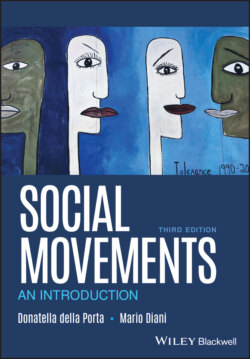Читать книгу Social Movements - Donatella della Porta - Страница 18
1.2.5 Social Movements and Protest
ОглавлениеUntil the early 1970s, debates on social movements emphasized their non‐institutionalized nature (see e.g. Alberoni 1984). Even now, the idea that social movements may be distinguished from other political actors because of their adoption of ‘unusual’ patterns of political behavior is still very popular. Several scholars maintain that the fundamental distinction between movements and other social and political actors is to be found in the contrast between conventional styles of political participation (such as voting or lobbying political representatives) and public protest (Rucht 1995). Protest is undoubtedly a distinctive feature of political movements, on which we shall largely focus in this book; while it is less conspicuous among movements focusing on cultural and personal change, like religious or countercultural ones (Snow 2005).
There are some objections to considering protest a core feature even of political movements. First, public protest plays only a marginal role in movements concerned with personal and cultural change, in religious movements, and the like. Cultural conflict and symbolic challenges often take forms such as the practice of specific lifestyles, the adoption or certain clothes or haircut, and the adoption of rituals that can only be regarded as protest if we stretch the concept to a very considerable degree (Snow 2005). Moreover, even in the political realm it is increasingly debatable whether protest can still be considered an “unconventional,” or even violent or “confrontational” activity. Various forms of political protest have become, to an increasing degree, part of the consolidated repertoire of collective action, at least in Western democracies. In general, protest seems no longer restricted to radical sectors, but rather, an option open to a much broader range of actors when they feel their relative position in the political process to come under threat (Dalton 2008; McCarthy, Rafail, and Gromis 2013).
At the same time, however, public protest still differentiates social movements from other types of networks like those referred to as ‘epistemic communities’ (Haas 1992, 2015; Keck and Sikkink 1998). These communities are organized around networks of individuals and groups with specific scientific and/or managerial competences in distinct policy areas. Like social movements, their members share a common frame of reference and take side on conflictual issues. The forms of structural ties and exchange of resources within those networks are however different from those that tend to characterize social movements. Epistemic communities involve actors usually endowed with decision‐making power and certified knowledge, as well as, often, electoral accountability. Instead, social movement actors usually occupy a peripheral position in decision‐making processes, and need to mobilize public opinion to maintain their pressure capacity. Even if some forms of protest are “normalized,” social movements tend to invent new disruptive forms of action—challenging the state on issues of law and order. It is true that, thanks to new communication technologies, forms of protest online have developed alongside more conventional ones, as illustrated by mail bombings or anonymous hackers entering protected sites of government or corporations (Coleman 2013; McDonald 2015). However, as the waves of collective mobilization at the turn of the century and from 2011 have confirmed, social movement politics is still to a significant extent “politics in the streets” (Gerbaudo 2012; della Porta and Mattoni 2014). The use of protest as a major source of pressure power has relevant effects on the structure and strategy of social movements.
